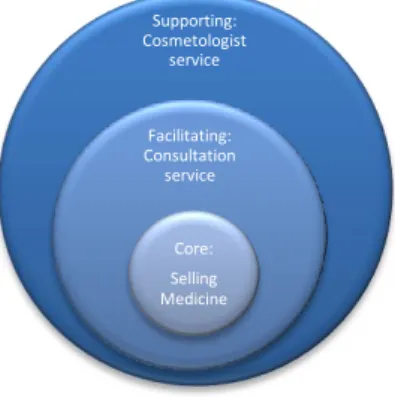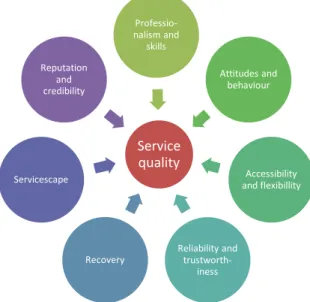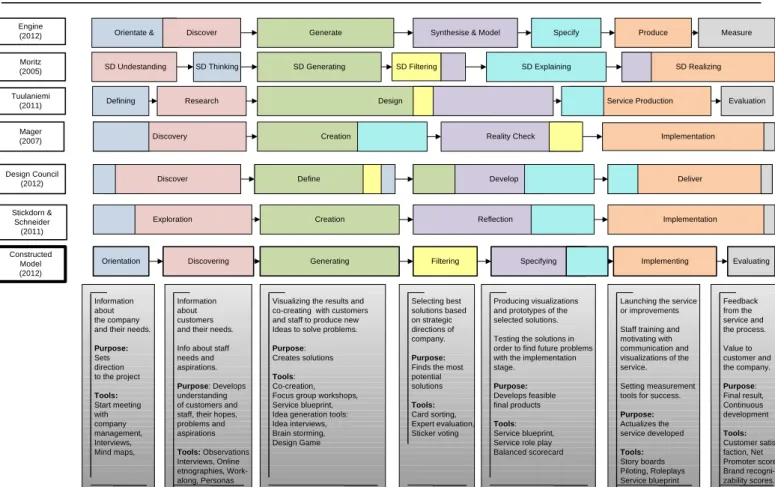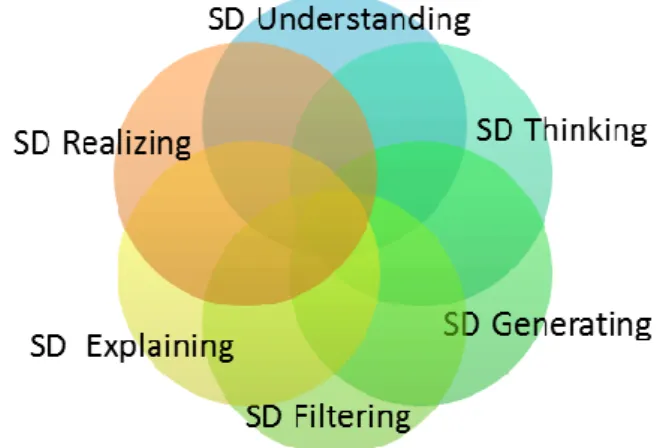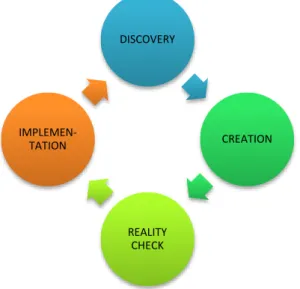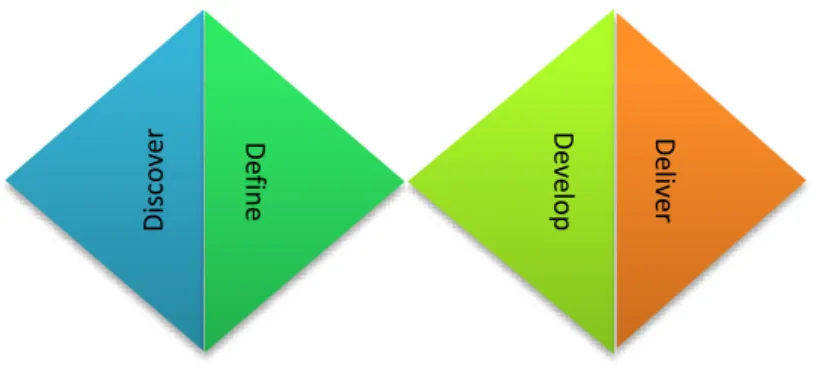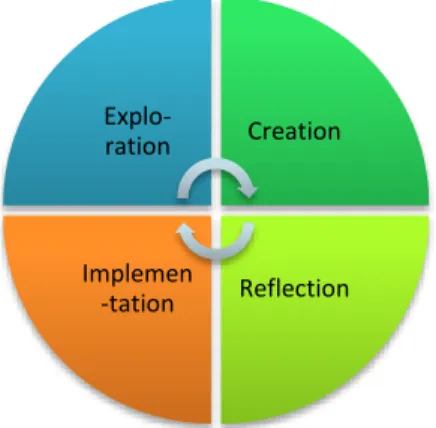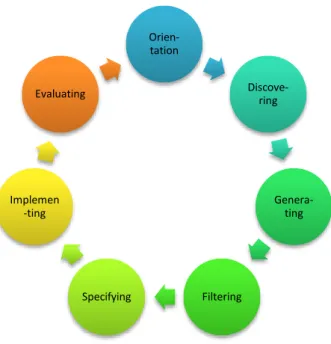In the service development project executed in the case pharmacy, the main methods used to collect customer information were the service plan, shadowing, contextual customer interviews, work ethnography and online. Based on the information gathered, solutions were created with the help of tools such as personas, employee focus group workshops, the design game that was developed for the workshop, and various idea generation tools.
Background of the thesis
Aims and objectives
Justification for the thesis
In the mystery shopper research mentioned above, the focus was more on the professional guidelines of the pharmaceutical consultancy. According to the results of the follow-up study, there was a slight improvement in counselling, product display in pharmacies was found to be more customer-oriented, and the ability of staff to consider customers was better than in previous years.
Research methods in brief and scope of thesis
The scope was chosen based on the wishes of the case pharmacy and because the process of serving customers with a prescription is more strictly controlled by laws and legislation and cannot be influenced as much.
Definitions
The service plan is a visual way to describe in detail all aspects of service production. The service plan is an excellent tool in service development, revealing the most important areas of service.
Structure of the thesis
What is service
Service offering
A service is often described as a package or set of tangible and intangible services. It answers the pure question of what is offered (Grönroos Brogowicz, Delene & Lyth In the case of pharmacies, the main service is the sale of medicines.
Service quality
Professionalism and skill criteria are met when the customers understand that the service provider and its employees have the knowledge, operating systems and physical resources needed to solve customer problems in a professional manner. Reliability means that the customers know that whatever happens or whatever has been agreed, they can trust the service provider and its employees' promises and that the company works for the benefit of the customer (Grönroos.
Developing existing service processes
Customer as a part of the development process
They are the experts of their own lives and behaviour, so it is important to include the customers in the service process from an early stage. By including customers in the co-creation process, they get a chance to add value to the service already in the development phase.
Including the service personnel to the process
The more involved the customer is in the service process, the more likely the service will engender co-ownership and through this increase customer loyalty and long-term commitment (Stickdorn & Schneider 2011.) Customer involvement has been shown to shorten the cycle development and provides the company with the opportunity to review and evaluate several new service ideas and concepts, which helps avoid the costs of failed service launches (Alam 2006). However, co-creation does not mean that all stakeholders of the service should decide what kind of services are produced, but the aim is that all aspects and views involved in the service are observed as widely as possible in the development phase. collecting and analyzing information. (Tuulaniemi.
Service design
Background of service design
Stages of service design process
Literature review on service design frameworks
- Engine’s model
- Moritz’s model
- Tuulaniemi’s model
- Mager’s model
- Design Council’s model
- Stickdorn and Schneider’s model
In the "Produce" phase, the touch points of the service are designed and developed and In the last stage of the process, called "Implementation", the new service is implemented.
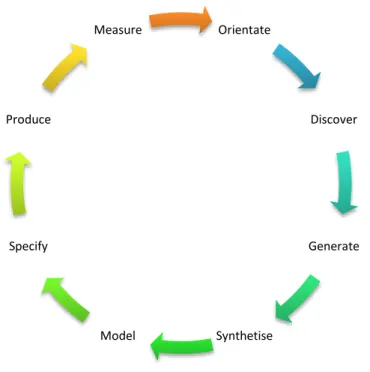
The theoretical framework of this project
- Orientation stage
- Discovering stage
- Generating stage
- Filtering stage
- Specifying stage
- Implementing stage
The tools used in the specification phase to visualize the service can be used again in this phase to train the staff. The value to the customer and company is assessed through various metrics set up in the previous stage.
Service blueprint
In the discovery stage, it was used to document the service process in the pharmacy based on the thesis worker's experience as a pharmacist. In the later stages, the service blueprint was specified and supplemented with development proposals based on the observations, interviews and focus group workshops to create the ideal customer path.
Shadowing
In a study by Kumar and Kwong, the service project was used in conjunction with other sigma tools to simplify and integrate a retail pharmacy process flow.
Contextual interviews
Work-along
Online ethnography
Personas
Focus group workshop
This was a great way to gain insight into work regimes, induction of new employees and other issues involved in the service process. It enables the interviewer to gather information from several people at the same time and often provides deeper insights and opinions than in traditional one-on-one interviews (Ojasalo, Moilanen & Ritalahti To avoid the typical pitfalls of this technique; the conversation that superficial or off-topic issues are needed, careful planning of conversation topics and guidelines (Hyysalo 2009, 133) It was planned to hold two workshops during the project, one for employees and one for customers.
Due to difficulties in getting enough participants for the customer workshop, it had to be cancelled. The employee focus group was combined with other Design Game participatory design techniques to involve employees in the design process.
Design game
The game was intended for pharmacy employees to step into the customers' shoes and see the service provided from a different perspective. Test players played test versions of the game and provided suggestions for development. The game itself consisted of five steps that followed the path of a buyer of an over-the-counter shopper in a pharmacy.
They also decided why the character came to the pharmacy, which was used later in the game. In this step, the task was to first consider which aspects of the solution are most important for the character we are playing.
Idea generation tools
At the end of the workshop, there was a short conclusion, where the employees had the opportunity to share with the whole group the key things they picked up during the workshop. If there was more time for the workshop, this part could be expanded so that the game and the ideas that arose during it could be discussed with everyone in the group.
Idea filtering tools
As a final phase of this project, the results were presented to the pharmacy's representatives. The results included the key results from the interviews, observations, work-along and the workshop. The improved service plan was also presented together with the new service concepts created during the project.
At the meeting, the representatives had the opportunity to ask further questions about the ideas and get a more detailed picture of the results. The pharmacy representative team was encouraged to use the completed idea post-its and card sorting tool at their upcoming internal meeting to categorize the 28 new ideas and 10 improvement suggestions (Appendix 9) according to their applicability.
Scenarios
Pharmacy Isokannel – description of the case company
Business idea
Strategy, vision and mission
Current stage of service development
Service development project in the Pharmacy Isokannel
- Orientation
- Discovering
- Generating
- Filtering
- Specifying
- Evaluation
These techniques provided insight into the behavior and needs of customers and revealed some areas of development in the current practice of pharmacy work. In the filtering phase of this project, representatives of Lekarna Isokannel were presented with a service plan for the ideal customer journey with developed development ideas. For this project, development ideas validated by pharmacy representatives were incorporated into the final ideal customer journey, which was shown in the service plan form found in Appendix 3.
The first part of this chapter explains the results of each tool used in the project. The second part then describes the final results of this project, the ideal customer journey with embedded development ideas formed from the data collected earlier in the project.
Results by tool
- Blueprint results
- Shadowing results
- Contextual interview results
- Work-along results
- Online ethnography results
- Personas results
This map was compiled from the customer journey observations made on the floor plan sheets of the pharmacy, demonstrated in Appendix 4. Half of the interviewees were greeted and eight out of 12 noted that they were smiled at. Working in the pharmacy revealed some small development areas from the employee perspective and gave a good understanding of the day-to-day functions of the company.
She wondered if the pharmacy customers were unaware of the pharmacists' duty to ensure the. Most of the new ideas generated were similar to the ideas already created by the author during this project.
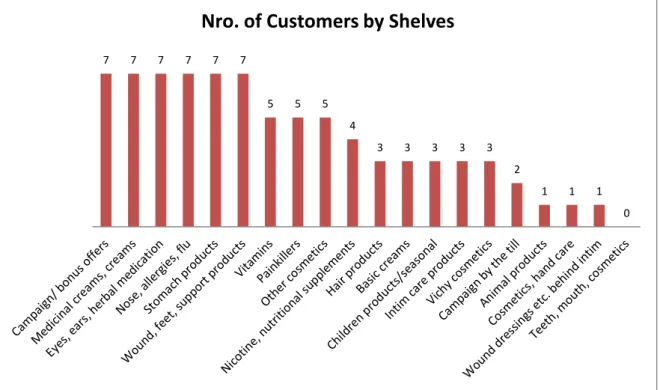
Ideal customer path
- The actors, the scene and the scheme of the scenario
- Finding the pharmacy
- Arrival to the pharmacy
- Prescription service encounter
- Non-prescription service encounter
- Cashier and leaving
- After the service
This can help customers more easily notice the different roles of pharmacy staff. The My Pharmacist service and the "Prescription Check" program were created by the author mainly based on the needs of the clients she faced in her work. What if someone from work saw him going in there?'' The pharmacy seems a more neutral place to meet with a mental health nurse.
In the interviews, the attitude towards the nurse (terveydenhoitaja) who worked in the pharmacy was examined. When asked, most interviewees also thought it was important to have a beautician in the pharmacy.
Key findings
- Functionality of the service design process
- Project results
- Applicability of results
- Limitations of the project
The stages of the process used in this project proved to be functional for the development of the pharmacy service. These tools provided good insight into customer satisfaction and the internal functioning of the pharmacy. Personas developed using insights from the discovery phase were then used in the later phases of the project.
New ideas and over-the-counter development suggestions are highlighted in red on the ideal plan. This would have been a useful way to gain more insight into the customer's perspective and co-create ideas with customers.
Recommendations for further study
Professional development & learning
Service launch or improvements Staff training and motivation with service communication and visualizations. A special person should be assigned to the end and more cosmetologist advertisement can be added. A short welcome letter to tenant staff with the most important issues related to the day-to-day operations of the pharmacy can be placed on the desktop of each computer to speed up service and prevent unnecessary interruptions of service appointments.
It was possible to collect feedback from the hired pharmacist on the functionality of the pharmacy processes. Attitude towards illness: He may not feel so bad and refuses to acknowledge the limitations of a long-term illness. He may abuse the products in his attempts to get the most out of the supplements.
Wants to be sure of safety and gets easily worried about small symptoms sometimes for no reason.
Service design models
Observed customer path as service blueprint model
Suggested service blueprint of an ideal customer path
Example of the floor plan sheet with observations
Photos of product groups & shelves in case pharmacy
Interview questions (in Finnish)
Design game board (in Finnish)
Summary of workshop ideas (in Finnish)
Service development ideas
Personas
